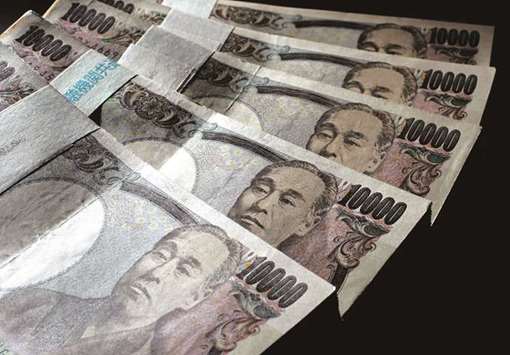The rally that’s made the yen 2018’s top performer among developed-market exchange rates will extend as speculators pick the Japanese currency over the euro to ride the US dollar’s weakness, say analysts.
Piggybacking on an economy that’s expanded for eight straight quarters, the yen has stolen the limelight from the euro this year.
The single currency’s gains have slowed after 2017 proved to be its best year in well over a decade amid bets the European Central Bank will scale back stimulus. Options traders are currently the most bullish on the yen among the Group-of-10 currencies.
“Focus is turning to the yen, with further euro-buying scope naturally being small after it was the strongest currency last year,” said Daisuke Karakama, chief market economist at Mizuho Bank in Tokyo. Unlike the euro, being long in the yen isn’t yet a “crowded trade,” he said.
Leveraged funds have reduced net yen short positions for five straight weeks, the fastest pace since August, according to the latest CFTC data. In comparison, their net euro long positions declined by the most since September in the week to February 13.
The yen reached 105.55 against the greenback on Friday, its strongest level since November 2016, as demand for haven assets rose amid a global stock rout. It has since weakened and was down 0.5% at 107.17 per dollar in London yesterday.
There will always be a certain degree of long-dollar positions against the yen as Japanese margin traders and long-term investors buy the greenback on dips, said Naohiro Nomoto, manager of foreign-exchange trading at Bank of Tokyo-Mitsubishi UFJ.
Speculators still see betting on further yen appreciation as “profitable” as they eye 105, according to Kengo Suzuki, chief currency strategist at Mizuho Securities Co in Tokyo. “Longer-term charts suggest a trend forming toward 101, driven by a combination of momentum, speculators’ positions and flows.”
The yen is laying the foundations for a move toward 100 against the dollar, technical charts show. The gains last week amplified the chances of a full reversal of the slide in late 2016, when it went from 100 to 118 per dollar after the US election of Donald Trump.
The dollar-yen’s recent bounce may prove short-lived as the market is coming off a week where the pair underwent significant technical damage, with major lines of defence fractured, opening a door to the 101.20-100 area.
Some money managers too are wagering the Japanese currency will strengthen further. AMP Capital Investors’ Nader Naeimi last week added to his long yen positions, while Singapore-based Kit Trading Fund, a hedge fund, is betting it will appreciate against the US and New Zealand dollars.
While the yen jumped 3.7% in the last two weeks alone, Japan’s Finance Minister said on Thursday that it hasn’t risen too abruptly to require intervention.
The Bloomberg Dollar Spot Index has been hovering near its lowest level since December 2014, weighed down by simmering US trade tensions and concern over America’s deficits.
“Markets awash with dollars from US fiscal expansion are driving dollar weakness now and prompting speculators to move the target to the yen,” said Koichi Takamatsu, head of G-10 currency trading for Japan at Nomura Securities Co in Tokyo.
It’s unclear as to what would prompt Japanese authorities to step in, he said, adding that “if there is little reason to be sensitive at these levels, then it’s hard to see speculators shorting the yen.”

The rally that’s made the yen 2018’s top performer among developed-market exchange rates will extend as speculators pick the Japanese currency over the euro to ride the US dollar’s weakness, according to analysts


